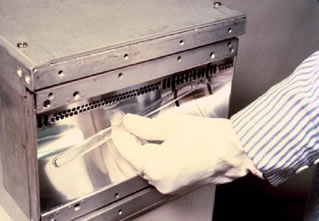Guide to UV Measurement
The Microwave-Powered Lamp
The microwave-powered lamp can be included in the general category of "medium pressure mercury vapor" lamps, but with a key distinction: microwave (RF) energy is transmitted directly into the UV-emitting plasma within the bulb volume rather than being driven by an arc between two metallic electrodes. This permits relatively simple construction of the bulb, owing to the fact that electrodes are not required. In turn, the electrodeless tubular bulb can be made much smaller in diameter. Typical outside diameters range from 10 to 18 mm.
The electrodeless bulb used in the microwave-powered lamp is simply a closed quartz tube that contains a small amount of mercury, an easily ionized "starter" gas, and “additives” to modify the spectral output. A high-frequency and high-intensity electric field, created by microwaves, excites the gas inside the bulb to extremely high energy and high temperature levels, vaporizing the mercury. |
|
The resulting high energy collisions of electrons, ions and gas molecules cause molecules to emit characteristic wavelengths of UV and light, in the [approximate] ratio of UV (~33 to ~42% depending on additives), visible (~25%), infrared radiation (~15%), and convected heat (~25%). The wavelengths of UV emitted and their relative energies are a function of the particular molecules and their concentration in the vaporized fill additive. There is nothing to cause changes in the spectral energy output during the normal operating lifetime of the bulb, typically in excess of 6,000 hours. The electrodeless bulb can be started, stopped, and restarted very rapidly, so does not require the use of shutters.
